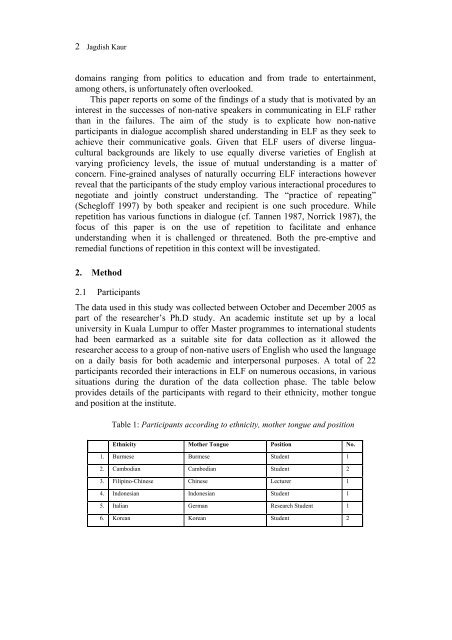Dialogue in and between Different Cultures - International ...
Dialogue in and between Different Cultures - International ...
Dialogue in and between Different Cultures - International ...
You also want an ePaper? Increase the reach of your titles
YUMPU automatically turns print PDFs into web optimized ePapers that Google loves.
2 Jagdish Kaur<br />
doma<strong>in</strong>s rang<strong>in</strong>g from politics to education <strong>and</strong> from trade to enterta<strong>in</strong>ment,<br />
among others, is unfortunately often overlooked.<br />
This paper reports on some of the f<strong>in</strong>d<strong>in</strong>gs of a study that is motivated by an<br />
<strong>in</strong>terest <strong>in</strong> the successes of non-native speakers <strong>in</strong> communicat<strong>in</strong>g <strong>in</strong> ELF rather<br />
than <strong>in</strong> the failures. The aim of the study is to explicate how non-native<br />
participants <strong>in</strong> dialogue accomplish shared underst<strong>and</strong><strong>in</strong>g <strong>in</strong> ELF as they seek to<br />
achieve their communicative goals. Given that ELF users of diverse l<strong>in</strong>guacultural<br />
backgrounds are likely to use equally diverse varieties of English at<br />
vary<strong>in</strong>g proficiency levels, the issue of mutual underst<strong>and</strong><strong>in</strong>g is a matter of<br />
concern. F<strong>in</strong>e-gra<strong>in</strong>ed analyses of naturally occurr<strong>in</strong>g ELF <strong>in</strong>teractions however<br />
reveal that the participants of the study employ various <strong>in</strong>teractional procedures to<br />
negotiate <strong>and</strong> jo<strong>in</strong>tly construct underst<strong>and</strong><strong>in</strong>g. The “practice of repeat<strong>in</strong>g”<br />
(Schegloff 1997) by both speaker <strong>and</strong> recipient is one such procedure. While<br />
repetition has various functions <strong>in</strong> dialogue (cf. Tannen 1987, Norrick 1987), the<br />
focus of this paper is on the use of repetition to facilitate <strong>and</strong> enhance<br />
underst<strong>and</strong><strong>in</strong>g when it is challenged or threatened. Both the pre-emptive <strong>and</strong><br />
remedial functions of repetition <strong>in</strong> this context will be <strong>in</strong>vestigated.<br />
2. Method<br />
2.1 Participants<br />
The data used <strong>in</strong> this study was collected <strong>between</strong> October <strong>and</strong> December 2005 as<br />
part of the researcher’s Ph.D study. An academic <strong>in</strong>stitute set up by a local<br />
university <strong>in</strong> Kuala Lumpur to offer Master programmes to <strong>in</strong>ternational students<br />
had been earmarked as a suitable site for data collection as it allowed the<br />
researcher access to a group of non-native users of English who used the language<br />
on a daily basis for both academic <strong>and</strong> <strong>in</strong>terpersonal purposes. A total of 22<br />
participants recorded their <strong>in</strong>teractions <strong>in</strong> ELF on numerous occasions, <strong>in</strong> various<br />
situations dur<strong>in</strong>g the duration of the data collection phase. The table below<br />
provides details of the participants with regard to their ethnicity, mother tongue<br />
<strong>and</strong> position at the <strong>in</strong>stitute.<br />
Table 1: Participants accord<strong>in</strong>g to ethnicity, mother tongue <strong>and</strong> position<br />
Ethnicity Mother Tongue Position No.<br />
1. Burmese Burmese Student 1<br />
2. Cambodian Cambodian Student 2<br />
3. Filip<strong>in</strong>o-Ch<strong>in</strong>ese Ch<strong>in</strong>ese Lecturer 1<br />
4. Indonesian Indonesian Student 1<br />
5. Italian German Research Student 1<br />
6. Korean Korean Student 2



